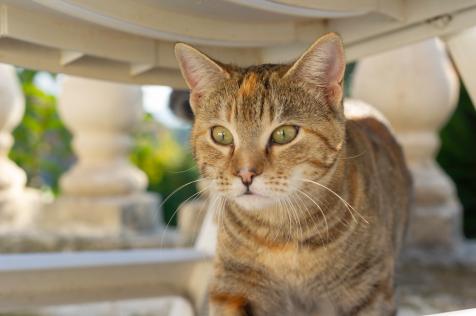Assessment of a new high protein – high essential fatty acid diet in cats with chronic skin and coat disorders

Introduction:
In general practice, dermatological cases constitute around 15 % of the caseload in cats and are the most common reasons for consultation.
It is well known that nutrition plays an important role in controlling skin and coat condition, especially some nutrients such as protein and essential fatty acids (EFAs) 2,3 .
The objective of this open study was to assess the efficiency of a new dry dietetic pet food intended for the "support of skin function in the case of dermatosis of excessive loss of hair" in cats.
1. Hill PB et al. Vet Rec 2006; 158 (16): 533. 2. Watson TDG. J. Nutr 1998; 128: 2783S. 3. Roudebush P and Schoenherr WD. Skin and hair disorders. In/ Small Animal Clinical Nutrition 2010: Chapter 32/637-643.
Animals:
- 44 client-owned adult cats with chronic skin disorders of nonspecific causes
- Average (SD) age: 4.5 (2.4) years old; body weight: 4.3 (1.3) kg; body condition score: 5.5 (1.1)
- Flea treatment before the start of the study
- No medical management allowed during the study
Diet:
- Metabolisable energy share: protein 41%, fat 38%, carbohydrate 21%
- Proteins (mainly from animal origin): 94%. Different fat sources: poultry fat, fish oil, linseed, sunflower oil, borage seed
- High and balanced level of EFAs: EPA+DHA=0.8% and LA+GLA=3.9% on a dry matter basis
- 8 weeks of feeding (test diet exclusively)
Assessments:
- 9 criteria evaluated: - 6 rated from 0 (severe alteration) to 4 (normal): coat shine, presence of dandruff, skin/coat odour, coat greasiness, coat softness and coat beauty - 3 rated from 0 (severe/frequent) to 3 (normal): licking frequency, itching frequency and hair loss.
- Assessments on Day 0 (D0, baseline) and every 2 weeks (W2, W4, W6 and W8)
- Body weight (BW) and body condition score (BCS) recorded at D0 and W8
- Other assessments: kibbles quality, palatability, preference, digestive tolerance and owners’ satisfaction
Statistics
- Analysis were done using repeated measures ANOVA and the adjustment procedure of Dunnett for pairwise comparison in case of significance. The time effect was considered significant at a 0.05 level.
Results:
Download the complete study at the end of the page
Conclusions
The test diet rapidly improved skin and coat condition of a great majority of cats. These improvements are likely linked to the composition of the diet: rich in animal protein as a source of sulphur-containing amino acids and balanced in omega-6 and omega-3 fatty acids. Palatability, digestive tolerance and owners’ satisfaction were good, which should allow a good compliance with the diet and maximize the chance of success for the management of chronic skin disorders. Clinical controlled trials with validated scales could now be carried out to assess the benefits of this diet in the management of specific skin.

